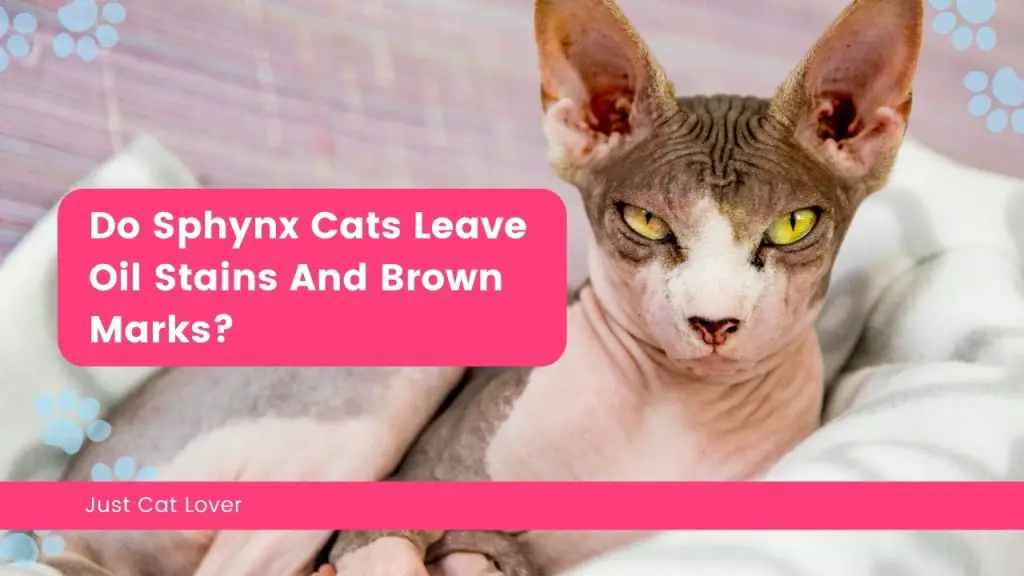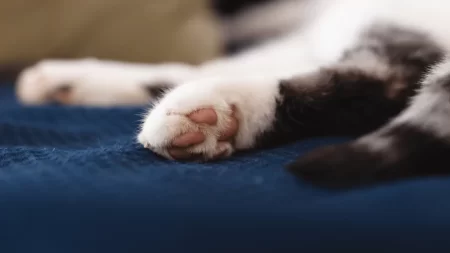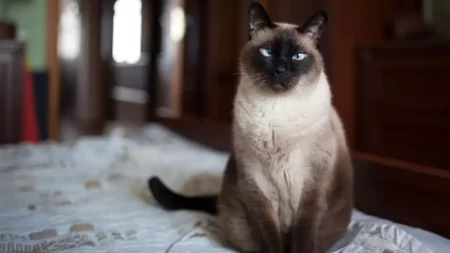Sphynx cats often leave Oil Stains And Brown Marks on frequented areas as a result of their naturally oily skin. While their diet can play a role in managing this oiliness, occasional baths using mild shampoo are necessary to eliminate any built-up dirt or filth from your Sphynx cat’s skin.
Sphynx cats are special! They’re prized for their hairless look and chilled-out temperaments. If you want a loyal pet, one of these cats may be perfect. Unlike other breeds, they don’t need much grooming. Plus, they’re usually obedient and love their owners. Often they follow them around the house or snuggle up with them at night.
These cats don’t have hair, but they do produce oil. It’s different from haired cats and can stain carpets, furniture, or fabrics. It can look like yellow or brown smudges. All Sphynx cats have some level of oil production, so it needs to be managed to stop permanent damage.
Do Sphynx Cats Leave Oil Stains?
Sphynx cats are a unique breed. They don’t have fur, which makes them susceptible to oil stains on their skin. These oils are created by glands, which can be overactive in some cats. This oil has an odor similar to human sweat. To protect fabrics and furniture, it is important to know how to remove oil stains.
The colors of the stains range from yellow to brown. If left untreated, the oils will soak into the fabric, making them hard to remove. Microfiber sofas can absorb oil from Sphynx cats, so consider using fabric covers to protect them.
Regular cleaning of items like cat trees and scratching posts are recommended. Weekly brushing also helps reduce the amount of loose dander and hair in your home and decreases the risk of sebum buildup over time.
Reasons for Oily Skin in Sphynx Cats
Sphynx cats are renowned for their lack of fur. This is due to the natural production of sebaceous cells, which secrete oil. This leads to oil stains and brown marks on their bodies.
There are several reasons why Sphynx cats produce more oils than other breeds. Firstly, they naturally produce more oils due to their hairless nature. This increases during the shedding of skin cells or when grooming themselves.
Other factors can also cause increased production, such as:
- Diet
- Hygiene habits
- Environmental conditions
To help keep your Sphynx free from oiliness, regularly bathe them and apply clumping litter or baby wipe to areas that are dirty or grimy.
If you think your cat’s oily skin is due to a medical condition or environmental factor, consult your vet. They may recommend dietary changes and appropriate treatments for your cat’s individual needs.
How to Control Oiliness in Sphynx Cats?
Sphynx cats are peculiarly hairless and require extra grooming and bathing. They also secrete a lot of oil, which can leave nasty stains on clothing, furniture, and any surface they come in contact with. You can keep your cat clean and reduce smelly messes by controlling oiliness. Here are some tips:
- Bathe weekly: Use a quality shampoo specifically designed for cats. This’ll help keep the skin from becoming too oily.
- Groom often: Use a damp cloth or grooming mitt several times a week to remove excess oils.
- Clean bedding frequently: Oil builds up quickly on bedding materials like blankets, towels, or cushions. Keep them clean.
- Lay mats under food dishes: Cats can spread oil while eating or drinking. Mats or absorbent materials will help minimize grease spots.
- Monitor shedding season: Most cats will naturally produce more oil during this period. Groom more frequently.
- Change diet: If oil production increases, consider changing your cat’s diet. Certain foods may encourage increased secretion of oils.
Benefits of Bathing a Sphynx Cat
Regular baths will help keep Sphynx cats’ skin healthy. They help distribute their natural oils. Brown marks on furniture, and strong odors, can be prevented with consistent maintenance.
Bathing ensures the skin is hydrated and free from dirt, debris, and oil. This also stimulates oil production. As a bonus, it’s a chance to check their body for underlying health issues:
- Hydrates the skin
- Removes dirt, debris, and oil
- Stimulates oil production
- Checks for underlying health issues
What Causes Brown Marks on Sphynx Cats?
Sphynx cats look regal and unique. They have no fur, instead having velvety skin. This lack of fur can cause problems with the spread of oil and brown stains.
The oil is produced by the cat to protect their skin, just like sweat does for humans. This oil is spread evenly over the cat’s body, but it can also be transferred onto other items with physical contact. The Sphynx cats might rub against items to spread this protective oil, and this may leave stains or brown smears.
It’s possible for the cats to have fecal residual on their behinds in the form of brown staining or spotting. If a Sphynx cat has this, it’s important to:
- Clean the area with a wet wipe or washcloth
- Prevent the home from being stained by oil or bodily waste
How Can Owners Safely Remove Oil Stains And Brown Marks From Sphynx Cats?
Sphynx cats have a tendency to leave behind oil stains, like other cats. Due to their lack of fur and loose skin, the oil often collects and forms dark-brown stains. To avoid spills and stains, it’s important to know how to clean them.
Bathing your cat with a gentle pet shampoo or specialized anti-grease shampoo will help break down the grease. For hard-to-reach spots, use white vinegar diluted with one part water, with paper towels, or cloth rags. Let the solution sit, then wipe away any darker spots or circles. Your home will be spick-and-span again!
Can Poor Grooming Habits Lead To Oil Stains And Brown Marks In Sphynx Cats?
Inadequate grooming can cause oil stains and brown marks to appear on Sphynx cats. While some Sphynx cats require less cleaning due to their reduced oil secretion, regular grooming is still essential to avoid such problems. For most hairless cats, weekly grooming that includes a bath, ear cleaning, and nail trimming is recommended. It’s also crucial to brush their teeth regularly to prevent dental issues.
Chin acne is a common skin condition in cats, including Sphynx cats, and it may be linked to insufficient grooming. Older cats are more prone to acne than younger ones, and it may also result from poor grooming habits. Neglecting the grooming of Sphynx cats can result in their oily skin leaving stains on upholstery and bed sheets that are difficult to remove. To prevent such issues, owners of Sphynx cats are advised to practice proper grooming habits.
Are Certain Coat Colors More Prone To Oil Stains And Brown Marks In Sphynx Cats?
Sphynx cats have gained popularity in the cat fancy for their unique appearance, characterized by their nearly hairless bodies. However, their lack of fur exposes a different set of challenges that require special attention from their pet parents. Sphynx cats naturally produce oils that are left on the surface of their skin, which can lead to the formation of reddish-brown oil buildups. Some Sphynx cats are more prone to oil stains and brown marks depending on their coat color, such as those with darker patches that can exhibit crusting on the surface of their skin.
How Often Should Sphynx Cats Be Bathed To Prevent Oil Stains And Brown Marks?
Sphynx cats are prone to getting dirty quickly and may develop brown patches on their skin. Due to their lack of fur, their skin accumulates oils that can cause an oily buildup and lead to stains on furniture and clothes. To prevent this, Sphynx cats should be bathed at least once a week using a medicated pet shampoo like Malaseb. Owners should also wash their blankets frequently and brush their teeth regularly. Using dust-free litter can also help reduce the need for frequent bathing. In summary, to prevent oil stains and brown marks, Sphynx cats should be bathed once a week and receive regular grooming.
Is There A Genetic Component To Oil Stains And Brown Marks In Sphynx Cats?
A genetic component contributes to the presence of oil stains and brown marks in Sphynx cats. These felines generate natural oils that stay on their skin, potentially resulting in reddish-brown buildup. While regular bathing aids in managing the problem, over-bathing may increase oil production. Additionally, excessive oils may cause skin issues like urticaria pigmentosa and cutaneous mastocytosis, as well as ear wax concerns. It’s crucial to note that, while Sphynx cats are less susceptible to messes and stains than furry cats, individual cats may vary in their tendency to develop oil stains and brown marks.
Conclusion
Thus, whilst Sphynx cats don’t have fur, they secrete oil from their skin. This substance resembles the sebum produced in furry cats. This oil can cause oily residue on furniture and brown streaks on walls. These are tough to evade and can be expensive to rectify.It is essential for owners of Sphynx cats to take extra precautions. Cleaning household surfaces with a damp cloth regularly is recommended. Offering scratching posts and other surfaces to the cats can help lessen the damage.







